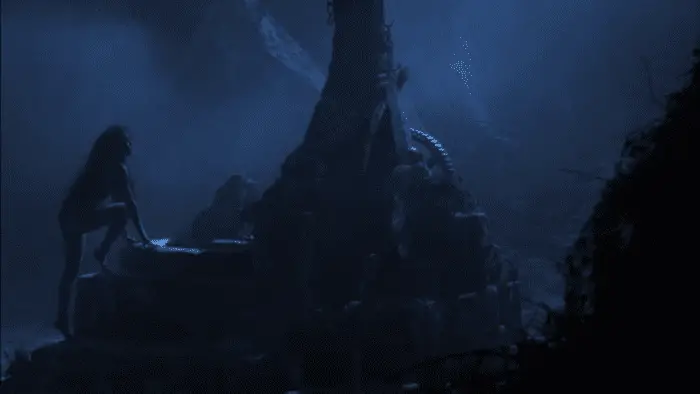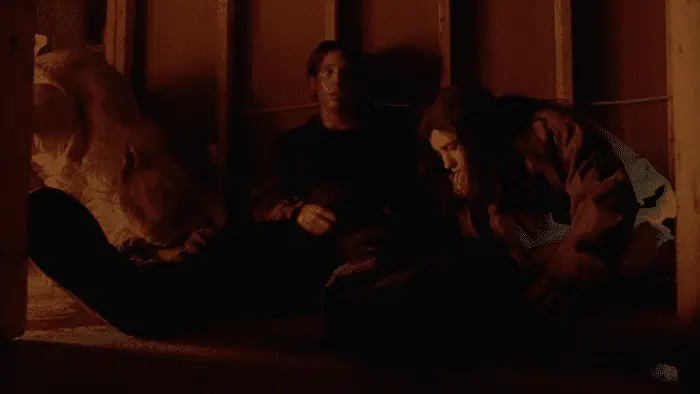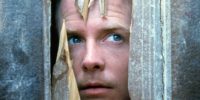Trigger warning: This article includes mentions of rape, suicide, and menstruation.
Werewolf movies are something of a rarity in the realm of mainstream horror. Even the ones that do exist and manage to garner themselves a cult following rarely break into the public consciousness in the same way that their vampire and zombie counterparts do, with perhaps the exception of The Wolf Man and An American Werewolf in London. Depictions of female werewolves are even rarer still, maybe because we tend to associate the traits characteristic of werewolves as more ‘male.’ Films that do tackle the subject of the female lycanthrope do so to varying degrees of success, and with different, sometimes moralistic undertones.
Neil Jordan’s 1984 film The Company of Wolves, based on Angela Carter’s short story of the same name, concerns itself primarily with the myth of werewolves and how this might lend itself to fears surrounding the adolescence of teenage girls. Even within the first minute of the film we get a sense of the juxtaposition between something soft and innocent and something darker and more dangerous—as the opening credits play, we see footage of a large dog bounding through a woodland area. The dog comes across a toy doll half-buried in this earth, sniffs it, and moves on. The use of toys to signify innocence, and dogs (and wolves) as something which threatens this innocence are motifs that are reused throughout the film.
On the other hand, the comparison between dog and woman, or at least dog and human, is established early on by intercutting shots of a young girl, Alice (Georgia Slowe), and her pet dog running around their house and up the stairs. We see Alice knocking on the bedroom door of her younger sister, accusing her of having stolen some lipstick. Inside the bedroom, the film’s protagonist, Rosaleen (Sarah Patterson), is tossing and turning in her bed, seemingly in the thralls of some unpleasant dream. On her lips, we can see the bright red lipstick that presumably belongs to her sister—an indication that she is beginning to experiment with more grown-up behaviours.
Rosaleen’s dream is disturbingly surreal. She imagines her sister stumbling through the forest, chased by an assortment of items that one might associate with a child’s bedroom such as a teddy bear and one of the dolls which sits in Rosaleen’s own bedroom. At the end of her dream, she imagines her sister chased and surrounded by a pack of wolves, unconsciously smiling in her sleep at the idea. The rest of the film revolves around this premise of Rosaleen dreaming, meaning the majority of the narrative takes place essentially inside her mind. This lends itself well to the highly metaphorical nature of the film, and it means we get a lot of dreamy, otherworldly set pieces, but the morals being espoused under the guise of this beautiful, dark world are a little more troubling.
The dream version of Rosaleen is an obvious stand-in for “Little Red Riding Hood,” and the dream narrative begins with her sister being attacked and killed by a werewolf. After this tragic death, Rosaleen is sent to live with her Grandma, who often tells her cautionary tales of wolves who are “hairy on the inside” and “drag you with them straight to hell” after “biting” you. According to Grandma’s words, it seems as though the wolves are meant to represent the predatory, sexually forward throngs of men that might theoretically be waiting to tear away Rosaleen’s virginity—not especially comforting words to a young woman moving into adolescence.
Where Rosaleen’s Grandma seems excessively negative about men and sex, her mother fleetingly offers a different perspective, telling her “if there’s a beat in men, it meets its match in women too.” Nowhere in the film is this more true than in the segment where Rosaleen gets to tell her own tale of a she-wolf from her village who is shot at but helped by the local priest to find safety within the walls of his church. At the end of the tale, the she-wolf returns to the village and vanishes down the well she originally came from. Although this is the first female werewolf properly established in the film, it is interesting that she is immediately ushered back into her birthplace, as if the narrative were saying she should never have existed, to begin with.
Eventually, Rosaleen runs away with a much older handsome stranger she meets in the woods who turns out to be a werewolf, and she joins his pack as a wolf, drawing a close to the dream sequence. Back in the real world, we see a pack of wolves running through Rosaleen’s house and up to her bedroom while she screams in fear. We are left with a rather obvious and exaggerated final message; as the wolves symbolically destroy the toys emblematic of Rosaleen’s childhood, we accept that her innocence has been thoroughly tainted. Rather than this being a moment of joyful awakening or something she is choosing for herself, we see only Rosaleen’s terror and discomfort, cementing Grandma’s words about the ‘wolves’ as the final truth of the film.

Another film that isn’t exactly stellar in its depiction of the sexuality metaphor is The Howling, a well-loved staple of the werewolf genre. At the beginning of the movie, Karen (Dee Wallace), an undercover newsreader, meets up with a man seemingly for a story she is pursuing in a small, darkened room in a shop. As the meeting takes a sour and violent turn, the man holds Karen by the head and makes her watch projected footage of a woman being sexually assaulted by several men. Although the room is too dark for us to see the man, it is clear that Karen is horrified by his appearance, and he begins to attack her until police arrive and intervene.
Following this incident and the apparently lethal shooting of the man, Karen understandably finds it hard to engage in intimacy with her husband, thinking back to the tape she was forced to watch and the threat she was under each time she does. The aftermath affects her job, too—she struggles to speak when going back on the air and is consequently referred to a therapist, who suggests she goes to stay at a rural commune in order to fully recover. Meanwhile, her co-workers investigate the man who attacked her, a werewolf who is explicitly linked to sexual violence. We are told that he rapes his victims, and his bedroom is decorated with images of nude women and newspaper clippings of his previous crimes.
Marsha (Elisabeth Brooks), a female werewolf living on the commune, is depicted as a seductress who entices Karen’s husband to the woods and sleeps with him. Repression is seen as the polar opposite of the liberated werewolves, as shown by Karen’s inability to sleep with her husband and the fact that she is sent to the commune by the doctor essentially to be ‘fixed.’ By this same token, however, Marsha, the only overtly sexual woman in the film, is portrayed as an antagonistic character as she participates in the infidelity of Karen’s husband.
The twist at the end reveals that the entire commune where Karen was sent to recover is in fact affected by lycanthropy, and they all turn on her at the end. Portraying all the bad guys as hypersexual werewolves and the main character as comparatively good by virtue of her unwillingness to participate in sex (even though this aversion was caused by trauma) is tiringly reminiscent of the Madonna-whore complex. Even more troubling still is the depiction of a serial murderer and rapist as a werewolf, a condition which traditionally leaves people utterly helpless and unable to contain the beast within.
This metaphor is especially tasteless and proves just how much the film misses the mark when trying to equate lycanthropy with the ‘cruel nature’ of men. The film ends with a monologue from Karen reaching out to the viewers of her news programme, telling them that they have a duty to fight against their “cruel and violent” natures and instead be kind and good, reiterating that this is the only thing that separates them from “the animals.” She attempts to shed light on the existence of werewolves, herself transforming on camera in order to prove her point. However, her words again point to the troubling bio-essentialist themes running throughout the film; violence and cruelty aren’t an inherent aspect of anyone’s nature, but rather products of an oppressive society, and using werewolves as a vessel to communicate the former idea is disappointing, to say the least. They deserve better.

Speaking of werewolves who deserve better, that leads me to the final and perhaps most iconic film on my list, which is of course John Fawcett’s Ginger Snaps. The film opens in a rather grizzly manner, with first the discovery of a dead dog and then with the two sisters Ginger (Katharine Isabelle) and Brigitte (Emily Perkins) discussing the suicides that they have planned for themselves. We are then treated to a slideshow of staged suicide photos that the two sisters have taken as the credits play. It’s dark stuff, but it aptly sets the tone for the rest of the film, which remains laced with morbidity despite the flashes of humour throughout.
At the beginning of the film it becomes apparent that one of the sisters, Ginger, is about to begin menstruating, something that she is extremely averse to. Both Ginger and her sister repeatedly refer to menstruation as “The Curse,” and once Ginger starts experiencing painful cramps, Brigitte passes it off as simple girlishness. To make matters worse, while they are out one night trying to prank one of their classmates, Ginger is attacked by a werewolf, thus beginning the central narrative of the film.
Ginger’s transformation into a werewolf is a pretty obvious analogy for her coming of age, but it’s the sheer relatability of her experience that makes the story successful. She begins to bleed and sprout hair from the cuts she received from the wolf, both of which she perceives to be scary and unnatural. Much to Brigitte’s dismay, she begins to take an interest in the boys at school whom she had previously brushed off. The relationship between the two sisters becomes increasingly turbulent as Ginger’s erratic behaviour escalates. After spending the night with a boy from school, Ginger returns home crying and covered in blood. Brigitte immediately asks her if the boy did something to her, but in reality it’s the other way round. The lines between regular lust and bloodlust are becoming blurred to Ginger, who delivers the iconic line:
I get this ache, and I thought it was for sex, but it’s to tear everything to f*cking pieces.
The distinction between Ginger Snaps and the previously mentioned werewolf films lies in how the storyline doesn’t stigmatize Ginger for experiencing sensual desires, and the overall perspective on intimacy is much less negative. The relationship between lycanthropy and sexuality is still pronounced—at one point, Ginger likens the act of killing to masturbation—but both are, at least to Ginger, acts of unashamed pleasure. Of course, there are flashes of maternal warning that echo the sentiments of Rosaleen’s grandmother in The Company of Wolves, such as when their mother says “some [boys] may seem cool or different, but they’re pretty much all the same.”
Ginger and Brigitte themselves regularly poke fun at other girls who they deem slutty, but it seems the film has at least some degree of self-awareness towards this judgment. While the girls are attempting to bury a body later on in the film, Ginger reassures Brigitte that no one would suspect girls of being capable of doing such a thing, since girls can only be “a sl*t, a b*tch, a tease, or the virgin next door.” The issue isn’t Ginger’s craving for intimacy, it’s the whole killing people thing, but even that has a certain level of truth to it in terms of the undirected rage and angst that a lot of teenagers feel.
In the last third of the film, Ginger’s behaviour is at its most violent and unpredictable, but the real conflict emerges from the power struggle between the two sisters. Brigitte starts to rebel against Ginger’s somewhat controlling ways, which serves to anger Ginger even more. The final act concludes with a face-off in the home of the two sisters. At one point Brigitte, who has by now been willingly infected by her sister’s lycanthropy, finds the bleeding body of her friend Sam in the basement and tentatively begins to scoop up handfuls of his blood to feed on it. Ginger watches from afar, now fully transformed into a wolf, and eventually approaches to give us one of the most striking shots of the film—Ginger and Brigitte, on either side of Sam feeding on his blood together.

The film tragically culminates with Brigitte having to stab an out-of-control Ginger, just after she yells “I’m not dying in this room with you, I’m not dying!” Her words are ironic considering the sisters’ morbid obsession with suicide at the beginning, but they also signify a renewed desire to live for Brigitte, and her definitive exit from her sister’s shadow. It’s interesting that although Ginger Snaps has a much more sympathetic portrayal, ultimately the female werewolf still becomes a source of fear and unbridled chaos that needs to be neutralised just as in the previous films discussed.
Werewolf narratives concerning women can’t seem to extricate themselves from the trap of making lycanthropy inherently sexual, and therefore condemning the sexuality of those who are burdened with it. There are many more aspects of the werewolf myth that could gain relevance when paired with a female werewolf, which Ginger Snaps heavily touches upon with the linking of menstruation and the wolf transformation cycle. It even plays around with ideas of gender with the phallic tail that Ginger must keep tucked out of sight. To this day, it is undoubtedly the closest and most interesting look at a female werewolf that we have on film, even though it is now two decades old. I think it’s about time we changed that.



Wow! What an interesting and insightful article. I have been a fan of Ginger Snaps since it came out and appreciate your analysis of Ginger’s passage through the liminal stage of adolescence into full-blown monsterdom.